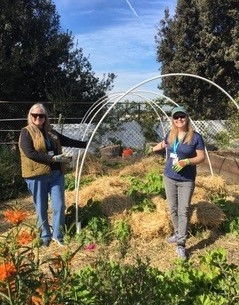Got Mulch?
Spring has officially arrived, and I am ready for gardening! I always get excited to see my seeds sprout and I enjoy giving them the tender loving care they need to establish resilient roots for later planting. The soil in my garden is in good condition, but I want to take one extra step of adding mulch to make sure the seedlings have the best chance for growing strong and healthy. There is nothing like fresh mulch to give a garden new life!
One question we often get as Master Gardeners is, “what type of mulch should I add to my garden”? There are so many varieties of mulch available at nurseries and home improvement centers, so selecting the best for your garden can be a bit overwhelming. Let's get back to the basics about mulch to help identify what best fits your garden needs.
Mulch is used in the garden to:
- help control weeds
- reduce the amount of water and timing needed for irrigation
- add nutrients to the soil
- retain soil warmth in winter and cool during extended hot weather
- enhance the look of the garden.
To better understand the benefits of mulch, let's consider how plants grow in their natural environment. Organic material from multiple seasonal growth cycles will accumulate in the surrounding areas. The organic material will decompose over time and add nutrients to the soil. In contrast, we tend to remove retired seasonal plants and litters of leaves from the garden for general aesthetic notions. Consequently, we need to reintroduce the lost nutrients to improve our soil. Adding layers of mulch can enhance the soil and growing conditions for your garden.
Mulches come in both organic and inorganic forms. Inorganic mulch comes from non-living compounds and includes synthetic chemicals. Whereas, organic mulch comes from living matter and do not include synthetic chemical additives.
Inorganic mulch is quite effective in blocking weeds, retaining water, and tends to last longer than organic mulch. Some examples of inorganic mulch include gravel, rocks, rubber, landscape fabric, and plastic sheeting. This type of mulch may also be altered in appearance, such as color-dyed rubber to simulate wood bark, for preferred curb-appeal landscapes.
There are a few things to consider when using the inorganic type of mulch. Rocks will not usually help to maintain soil moisture and can absorb heat, so make sure that you garden plants can handle this type of environment. Plastic sheeting will not allow water or nutrients to penetrate the soil, and suppresses beneficial insects and microorganisms that are crucial for soil to thrive. Keep in mind that inorganic mulch will not add soil nutrients and other supplements that may be needed, another item for your chore list.
If you are looking for a mulch that will add important nutrients to the soil, it is better to go with the organic type. Some examples of organic mulch include wood bark and chips, grass clippings, straw, cocoa hulls, and compost. Organic mulches tend to be more expensive, but will lead to a more healthy soil for seasonal plantings.
There are different types of organic mulches, and each offer its own unique benefits to the soil. Your choice in mulch will depend the specific plants you are growing in your decorative, vegetable or flowering garden. For example, hardwood chippings will turn your soil acidic during decomposition, while softwood chips will decompose more quickly and add more nutrients to your soil. Woodchip mulch is good for trees, bushes and shrubs, or just for its appearance longevity.
Straw is good for starting a veggie garden, straw and compost are probably the best options. Straw is very useful in preventing the plants and lower leaves from touching the soil, which can cause diseases. Just make sure to get straw and not hay, which can have seeds that produce invasive weeds.
Compost is an excellent choice for most types of gardens. Compost consists of organic materials like newspapers, grass clippings leaves and food wastes. This source material will decompose down into dark humus and will be rich in nutrients, which is the reason why gardeners generally refer to this mulch as “black gold”.
You will still need to do some homework on the specific mulching needs for your selected garden. Who knows, your research may also lead to new fun projects, like starting your own compost pile at home.

Wood chip mulching at Pena Adobe Willis Linn Jepson Garden 2 – photo by Paula Pashby

Wood chip mulching at Pena Adobe Willis Linn Jepson Garden –photo by Paula Pashby


